Chilled dough creates a flakier, more tender quiche shell by preventing the butter from melting too quickly, which helps maintain distinct layers. Room temperature dough tends to be softer and may result in a denser, less crisp crust because the butter blends more thoroughly into the flour. For the best-textured quiche shell, starting with chilled dough is essential to achieve that perfect balance of crispness and tenderness.
Table of Comparison
| Aspect | Chilled Dough | Room Temperature Dough |
|---|---|---|
| Texture | Crispier, flakier shell | Less flaky, softer crust |
| Easiness to Work | Firm, easier to roll and shape | Soft, prone to sticking and tearing |
| Shrinkage | Minimal shrinkage during baking | Higher risk of shrinkage |
| Butter Incorporation | Better butter layers create flakiness | Butter melts, risking greasy dough |
| Baking Result | Even browning and structure | Uneven baking and potential sogginess |
| Preparation Time | Requires chilling time (1+ hour) | Immediate use, no chilling needed |
Introduction: The Role of Dough Temperature in Quiche Making
Chilled dough for quiche shells maintains a firm texture that prevents shrinking and promotes flakiness during baking. Room temperature dough, while easier to roll, can become overly soft and sticky, resulting in a less crisp crust. Controlling dough temperature is essential for achieving the ideal balance of tenderness and structure in quiche crusts.
Chilled Dough: Definition and Benefits
Chilled dough for quiche shells refers to pastry dough that has been refrigerated before rolling and baking, allowing the fats to solidify and the gluten to relax. This process results in a flakier, more tender crust that resists shrinking and maintains its structure during baking. Cooling also minimizes dough stickiness, making it easier to handle and ensuring a crisp, evenly baked quiche shell.
Room Temperature Dough: Definition and Characteristics
Room temperature dough for quiche shell refers to dough that has been allowed to sit outside the refrigerator until it reaches ambient kitchen temperature, typically around 68-72degF (20-22degC). This dough exhibits increased pliability and elasticity, making it easier to roll out and shape without cracking compared to chilled dough. The slightly warmer temperature promotes gluten relaxation, resulting in a more tender crust with less shrinkage during baking, ideal for delicate quiche fillings.
Texture Differences: Flakiness vs. Tenderness
Chilled dough for quiche shells produces a flakier texture by allowing the butter to remain solid, creating distinct layers during baking. Room temperature dough yields a more tender crust due to the butter blending evenly with the flour, resulting in a softer, less layered structure. Choosing chilled dough enhances crispiness and defined flakiness, while room temperature dough emphasizes a delicate, melt-in-your-mouth tenderness.
Ease of Handling: Workability of Each Dough Type
Chilled dough provides superior ease of handling for quiche shells, as its firmness prevents sticking and tearing during rolling and shaping. Room temperature dough is softer and more pliable, which may simplify initial manipulation but can become sticky and prone to stretching, complicating precise shaping. Overall, chilled dough ensures better workability by maintaining structure and reducing the risk of overworking the gluten.
Impact on Baking Time and Evenness
Chilled dough for quiche shells typically results in a more consistent baking time due to its firmer texture, which helps maintain shape and prevents shrinking during baking. Room temperature dough may bake faster but risks uneven cooking and increased spreading, leading to an irregular crust thickness. Maintaining the dough at recommended cold temperatures optimizes evenness and reduces the likelihood of a soggy or underbaked bottom.
Flavor Profile: Does Temperature Affect Taste?
Chilled dough for quiche emphasizes a flakier, richer crust as cold butter retains its structure, releasing steam during baking that enhances texture and buttery flavor. Room temperature dough often produces a denser shell with a milder taste since the butter blends more thoroughly but loses some steam-driven lift, reducing flakiness and richness. Temperature directly influences the crust's mouthfeel and flavor intensity, making chilled dough preferable for a more distinct, layered taste in quiche shells.
Preventing Shrinkage: Which Dough Performs Better?
Chilled dough outperforms room temperature dough in preventing shrinkage for quiche shells due to its firmer structure, which reduces gluten activation and minimizes dough elasticity during baking. Keeping the dough cold maintains the solid fat particles, creating steam pockets that help the crust maintain its shape and avoid contracting. In contrast, room temperature dough tends to become overly soft, increasing the likelihood of shrinkage as the fats melt too early, causing the crust to pull away from the pan.
Expert Tips for Perfect Quiche Shells
Chilled dough creates a flakier, more tender quiche shell by allowing the butter to remain solid, preventing excessive gluten development and shrinkage during baking. Room temperature dough tends to be stickier and can result in a tougher crust due to premature butter melting and increased gluten activation. Experts recommend chilling the dough for at least 30 minutes before rolling to achieve a crisp, evenly baked shell with optimal texture.
Conclusion: Choosing the Right Dough Temperature for Your Quiche
Chilled dough produces a flakier, more structured quiche shell by preventing premature butter melting and ensuring a tender texture. Room temperature dough is easier to roll out but risks a denser, less crisp crust due to softened butter blending too quickly. For a perfectly flaky and crisp quiche shell, using chilled dough is the optimal choice.
Chilled dough vs room temperature dough for quiche shell Infographic

 cookingyes.com
cookingyes.com